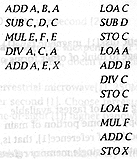| 4. |
(a) Write programs to compute |
[8] |
|
|
X := (( A + B ) / ( C - D )) + (
E * F ) |
|
|
for 3-address and 1-address
machines with instructions sets as follows:
3-address |
1-address |
| |
LOA M |
AC ¬ M |
| |
STO M |
M ¬ AC |
| ADD X, Y, Z |
Z ¬ X + Y |
ADD M |
AC ¬ AC + M |
| SUB X, Y, Z |
Z ¬ X - Y |
SUB M |
AC ¬ AC - M |
| MUL X, Y, Z |
Z ¬ X * Y |
MUL M |
AC ¬ AC * M |
| DIV X, Y, Z |
Z ¬ X / Y |
DIV M |
AC ¬ AC / M |
|
|
|
Good
answers are : |
|
|
|
 |
|
|
Award up to [4] per
program. Full marks if the program delivers the correct value into X. Deduct [1] for
failing to write answer to X, Deduct [1] for each sub-expression that is wrongly
evaluated. |
|
|
|
|
|
(b) Suppose that the instructions
shown above are the only instructions available on these machines, and suppose
that all addresses/operands are 4 bits. What is the minimum size for the instructions of
each of the two machines? |
[4] |
|
3-address: 4
instructions, which is 22. Therefore 2 bits needed for op code field; |
[1] |
|
3 * $ bits for address
+ 2 for opcode = 14. |
[1] |
|
1-address:
6 instructions, therefore need up to 23 opcodes; 3 bits needed; |
[1] |
|
4 bits for address + 3
opcode = 7. |
[1] |
|
|
|
|
|
(c) Use your answer to part (b) to
calculate which of your two programs will occupy more storage space (in bits). Would the
answer be different if addresses were 32 bits? |
[4] |
|
Any reasonable
3-address program will have five instructions, and will therefore need 5 * 14 = 90 bits. |
[1] |
|
The storage for the
1-address program will depend on the number of instructions used: 11 instructions: 77
bits, 12 instructions: 84 bits; 13 instructions: 91 bits; 14 instructions 98 bits. |
[1] |
|
Therefore, the
3-address program occupies less space. |
|
|
Corresponding answers
for 32-bit addresses, 3-address: 490 bits; 1-address, 11 instructions: 385 12
instructions: 420 13 instructions: 455 14 instructions: 490. |
[1] |
|
Therefore the answer
will usually be different for the 32-bit addresses. |
[1] |
|
Allow
consequential marks throughout this question. |
|
|
|
|
|
|
(d) Which component within the CPU
is used to process instructions such as ADD, SUB, MUL etc.?
Give two other instructions which might also be processed by this component. |
[4] |
|
The arithmetic logic
unit |
[2] |
|
Any boolean
instructions, |
[2] |
|
e.g. and, or, not,
etc. |
|
